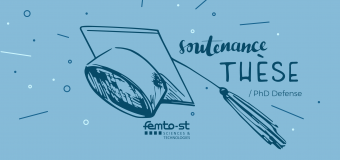You are here
- Home
- Daniel GUNEYSU : "Integrated microfluic device for EVs qualification: development of calibration particles and immuno-biochips"

Daniel GUNEYSU : "Integrated microfluic device for EVs qualification: development of calibration particles and immuno-biochips"
Tuesday 21 July 2022 - 10h00 A.M.Abstract : The aim of the MADNESS project is to define an analytical solution to sort and qualify extracellular vesicles (EVs), contained in almost all biological fluids. This thesis has focused on the development of the device which captures EVs and also focused on the development of several internal synthetic calibrants which certified the performances of this module.
The NanoBioAnalitycal module (NBA module) is a miniaturized way of immunocapture of EVs which will be the last part of the global MADNESS solution. The module ambition is to be a complementary part of the immunocapture phase in biodetection equipment as SPRi. The fluidic settings were determined by using the Comsol® software to do simulations of flow and confirm it by microfluidic tests (determination of flow rate in correspondence to the range of pressure applied). The immunocapture part has been validated by using different biomimetics microparticles (mimicking EVs) : 140 nm and 480 nm diameter particles were biofunctionalized with 2 standard proteins : casein (CAS) and ovalbumin (OVA). The resulting NPs called NP140-CAS/NP140-OVA and NP480-OVA will be used as internal calibrants during immunocapture process. The preparation protocol including biochemical and biophysical characterization have been validated and are used as a model for all preparatory and analytical process of the global MADNESS solution. The biodetection settings in terms of dynamic range and limit of detection were determined in buffer conditions (between 107 to 109 particles per ml for all calibrants). The validation of their role was made in complex samples by spiking natural EVs. In this way, we made sure that there is no cross-contamination between immunocapture spots and make sure that we can use it indifferently in a controlled medium or in a biological one.
The last part has been reached in the MADNESS project by coupling in a first configuration the sorting device (developed by LAAS-CNRS institute) and the NBA module. Despite, limited experimental conditions (flow rate, time, concentration), the module shows a good accuracy of functioning (sensibility and specificity) in more and more complex biological environments contributing to using the MADNESS solution in human plasma.
The work has been valued by several scientific communication (poster and oral) in different national and international conferences and the publication of an article in a conference paper
Jury composition :
Wilfrid BOIREAU, Directeur de recherche, Université Bourgogne Franche-Comté, PhD Director
Anne-Marie GUE, Directrice de recherche, LAAS-CNRS, Reviewer
Eric LESNIEWSKA, Professeur, ICB université de Bourgogne, Reviewer
Céline ELIE-CAILLE, Maîtresse de conférences, Université Bourgogne Franche-Comté, PhD CoDirector
Jérome DEJEU, Maître de conférences, Université Grenobles-Alpes, Reporter
Joel CHOPINEAU, Professeur, Institut Charles Gerhardt, Reporter
Localization : Amphitéâtre Jean-Jacques Gagnepain, 15 B avenue des Montboucons 25000 BESANCON









